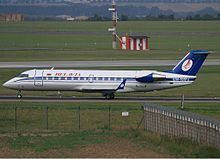Passengers 18 Injuries (non-fatal) 7 Date 14 February 2008 Crew count 3 | Fatalities 0 Survivors 21 (all) Number of deaths 0 Passenger count 18 | |
 | ||
Summary Wing contamination (ice) leading to loss of lift and stall after takeoff Similar 2008 Chișinău Antonov, Sudan Airways Flight 109, 2008 Macedonian Armed Fo, 2008 Conviasa Boeing 7, Hewa Bora Airways Flight 122 | ||
Belavia Flight 1834 was a scheduled international passenger flight from Yerevan, Armenia, to Minsk, Belarus, operated by Belavia. On the morning of February 14, 2008, the Bombardier Canadair Regional Jet carrying 18 passengers and three crew crashed and burst into flames shortly after take off from Zvartnots International Airport near Yerevan, the capital of Armenia.
Contents
The jet hit its left wing on the runway during takeoff, crashed to the ground, flipped over, and came to rest inverted near the runway. All passengers and crew managed to escape the aircraft before it erupted into flames, partly due to the timely response of the fire and rescue crews. There were no fatalities, but seven people were taken to hospital for treatment.
Aircraft and crew
The aircraft involved, EW-101PJ (MSN 7316), was a 50-seat Bombardier CRJ-100ER. It was a fairly new member of the fleet since it was leased by the airline and delivered in February 2007. The aircraft was built in 1999.
Passengers
There were 10 Armenians, five Georgians, a Russian, a Ukrainian, and a Belarusian among the passengers. The Russian Interstate Aviation Committee (MAK) final report in Russian found that seven passengers received serious injuries while the remaining 11 passengers and three crew were unhurt. There were no fatalities.
Crash
The airplane had arrived at Yerevan two hours before scheduled departure and was preparing for departure as flight B2-1834 from Yerevan (Armenia) to Minsk (Belarus) with 18 passengers and three crew. Refueling was done in automatic mode 25 minutes after landing, and 2,200 liters (1,802 kg) of Jet-A-1 fuel were added to the tanks. Due to reported reducing visibility at the main alternate airport, the crew decided to add another 400 liters of fuel about 30 minutes later during flight preparations.
The first officer performed the preflight check of the aircraft about 15 minutes after landing (and before refueling) and found all aerodynamics surfaces clean and dry by visual inspection as well as by touching the surfaces with the palm of his hand. The report mentioned that weather conditions that are susceptible to frost contamination require the pilot in command to perform the preflight walk-around.
The weather at the time was: winds from 110 degrees at 2 knots (4 km/h; 1 m/s), visibility 3500 meters (11500 feet) in light haze, clouds overcast at 790 m (2,600 ft) scattered at 3,000 m (9,800 ft), temperature -3 °C, dew point -4 °C and QNH 1019 hPa. The crew computed V speeds of V1 at 137 knots (254 km/h), VR at 139 knots (257 km/h) and V2 at 145 knots (269 km/h). After engine start the crew activated the anti-ice systems of the engines, but the wing anti-ice systems were not activated.
The airplane banked progressively left after liftoff until the left wing touched the ground with the airplane veering left of the runway, rolled right separating the right hand wing, crossed the runway rolling on its back and disintegrated coming to rest right of the runway. Leaking fuel triggered a ground fire, which was quickly brought under control by the airport fire fighters.
Gayane Davtyan, a spokeswoman for the General Department of Civil Aviation of Armenia said that the jet, operated by the Belarusian airline Belavia, hit its left wing on the runway during takeoff and erupted into flames.
Fire and rescue crews were reportedly on site within 50 seconds. The passengers also helped the crew members out of the cockpit.
Yerevan’s Zvartnots airport was temporarily closed after the crash, which took place at 04:15 local time. As of 10:30 local time, the airport was still closed while arrivals were being diverted to Gyumri's Shirak Airport. The first plane expected to land at Zvartnots was from Tehran at 11:30 local time.
Investigation
Initial speculation pointed to icing on the wings which caused the left wing to stall upon lift-off. Icing conditions were reported at the airport during the crash, and the CRJs are very prone to wing contamination and icing since they do not have any leading edge devices.
The Interstate Aviation Committee (MAK) performed a test employing a CRJ-900 registration D-ACKK to assess the accumulation and freeze of atmospheric moisture with large temperature differences between the ambient air and the remaining fuel in the tanks after landing. It was found that ice accumulated on the underside of the wing immediately after landing and grew 25 minutes after landing upon refueling. The upper side of the wing showed dew accumulation after refueling. The fuel temperature at the time of arrival was measured at -21 °C, and before departure at -12 °C with an ambient temperature of plus 8 °C.
At the time of the accident it could therefore be assumed that the temperature of the fuel in EW-101PJ never got above -12 °C with an ambient temperature of -3 °C.
Investigation teams from the General Department of Civil Aviation of Armenia, from Belarus, and from Bombardier participated in the investigation to determine the probable cause of the accident.
Final report
The Russian Interstate Aviation Committee (MAK) released their final report in Russian which concluded that the most probable cause of the accident was:
